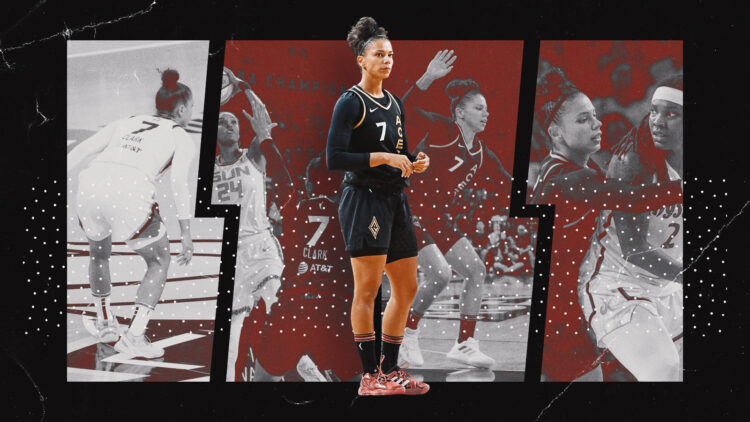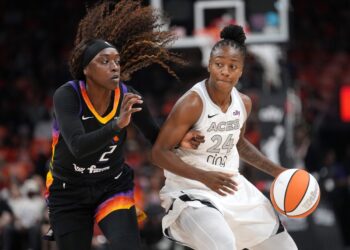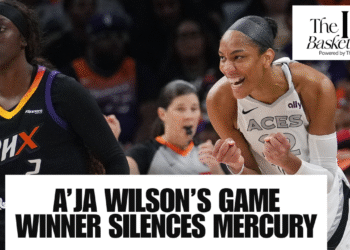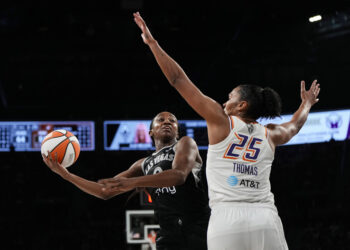Okay, bear with me. A Las Vegas Aces team clinching their second championship in as many years with six players ranking in the top 10 in defensive rating (DRTG) last season is a sure sign of their defensive prowess. I’m not telling you anything you didn’t already know. And it isn’t like the reigning Sixth Woman of the Year Alysha Clark suddenly became good at defense overnight. The 36-year-old has maintained her reputation as one of the most challenging opponents in the league since her early days when she clinched championships alongside Breanna Stewart for the Seattle Storm. Clark was First-Team All-Defense in 2020 and Second-Team All-Defense in 2019. The league and you alike have known what Clark can do defensively, but what you may not know is Alysha Clark, after 11 seasons in the WNBA, is still the league’s premier defender, and it has nothing to do with the defensive numbers she puts up. Almost nothing.
Here’s why.
Let’s start with the numbers. Clark’s 22.5 minutes per game (MPG) last season were on the lower end for her career, but when you’re coming off the bench on a team that has Kelsey Plum, A’ja Wilson, Candace Parker, Jackie Young and Chelsea Gray as its starters, each of whom also finishing in that top 10 DTRG, you’re not going to get starter-like minutes. She was usually the first player off the bench, and among players who played at least 20 MPG and played in at least 30 games last season, Clark was first in DRTG. Using those same parameters, Clark was also first in opponents’ points off turnovers, third in opponents’ points in the paint, ninth in opponents’ second chance points and 15th in defensive win shares per game.
As the second oldest player on the team, you might excuse Clark slipping a bit defensively to allow the youngbloods to do much of the heavy lifting, but not here. Collectively, these numbers indicate a consistent and high-end defensive talent coming off the bench for the Las Vegas Aces.
However, Clark doesn’t steal many passes or block many shots. She could also stand to box out more consistently. According to Synergy Sports, her 0.854 points per possession (PPP) against was within the 65th percentile, a rating of “good” on their site. Additionally, she averaged just over two fouls per game (FPG), only 32nd in the league of players who averaged at least 20 MPG.
I get it. These numbers demonstrate a quality defensive player, but I said premier defender. That’s why the numbers only tell part of the story. The rest comes from the instincts, experience and leadership Clark takes on the defensive side of the ball. She’s routinely guiding her teammates—sometimes physically moving them and sometimes with a simple finger point—to ensure the upper hand in the possession battle.
Specifically, one of the signs of an elite defender is toughness, especially the toughness to fight through screens.
In the above example, Clark reads the Connecticut Sun’s Ty Harris like a book, recognizing the pindown screen coming her way. Clark immediately repositions her body to brace for contact while also improving her angle to fight through not only Harris’ screen but Alyssa Thomas’ as well, forcing Thomas into fouling Clark. This work doesn’t come just from instinct. It requires a commitment to defensive basketball to read where the screen is coming from and prepare oneself to gain the matchup advantage.
This is another example of Clark’s ability to fight through screens and stay in plays. One of the fundamental requirements for any defender is to always keep their head on a swivel, ready for not just what their primary assignment might do but also what the offensive players within one pass might do as well. Note in the clip above how Clark keeps her eye on what’s happening in front of her rather than solely on her assignment, allowing herself to watch the play develop and attack. While she initially gets caught on the Kia Nurse screen, she fights through to remain in a shot-challenging position on the Jewell Loyd three-ball.
The above example exemplifies several things Clark does well and what makes her the premier defender she is. In the initial action, the Seattle Storm’s Sami Whitcomb sets a slip screen for Jordan Horston. Except, the true action was for Horston to set a screen and make space for a Whitcomb three. As soon as Whitcomb sets the slip screen, Clark anticipates a possible baseline cut from Horston and immediately motions for Wilson to cover the baseline. As Whitcomb establishes herself on the three-point line, Clark fights through the Horston screen to establish her position and challenge the shot.
Fighting through screens takes perseverance, effort and quick reflexes to recognize the situation. Clark never quits on the defensive end of the ball, always looking to make the right play each time down the court. Her ability to fight through screens and challenge looks is why she gives up few points per possession.
Another vital defensive tactic is staying out of foul trouble. Yes, Clark can occasionally find herself in foul trouble, but a lot of that comes from her aggressive defensive effort and not anything fundamentally unsound. One way to stay out of foul trouble is by routinely moving your feet defensively, ensuring your body remains in front of the ball handler at all times.
The above clip is a fantastic example of Clark’s footwork. Clark’s assignment is the Storm’s Arella Guirantes, who’s coming off a Mercedes Russell screen with a full head of steam. Clark instantly picks up Guirantes off of the screen, shuffling her feet to cut off the lane to the basket, forcing Guirantes to pick up her dribble. Guirantes attempts several maneuvers to get around Clark, who remains square to the ball handler. Additionally, Clark pressures Guirantes with a few swipes and body-checking, which ultimately leads to a traveling call.
In this example, Clark has to slide past the Los Angeles Sparks’ Nneka Ogwumike to stay with her assignment, Zia Cooke, fending off an Ogwumike screen attempt and remaining in front of Cooke as she quickly drives to the hoop. Clark’s athleticism keeps her balanced as she uses her long strides to reestablish contact with Cooke and remain attached on her hip, preventing her from getting a clean look at the basket and eventually a clean block.
A similar situation developed against the Storm. Clark’s assignment is to not allow Loyd, one of the best offensive players in the WNBA, to get free. Clark fights through an Ezi Magbegor screen, only to find herself on an island trying to prevent a pull-up three or dribble-drive to the hoop. Loyd chooses the latter, attempting to utilize a slip screen from Magbegor. Clark wisely opens her hips to give her a better angle, and while it appears as though Loyd has the lane, Clark remains on Loyd’s back hip, and when Loyd initiates her shot, Clark regains her positioning and blocks the shot clean.
What these clips have identified is Clark’s penchant for forcing tough shots. It’s every defender’s goal to force your opponent into poor-quality looks, but a lot of that comes down to what a defender does long before the shot. This defense requires the pin-point focus, instincts and basketball IQ that Clark always reflects, highlighting her consistent ability to be the league’s premier defender.
Another component of sound defense is understanding gap coverage and help rotations. As discussed, Clark is a phenomenal communicator, especially on the defensive side, which is the initial requisite for defensive rotation.
In the clip above, Clark’s help rotation is what shuts down the Storm’s easy look at the rim. Loyd draws plenty of attention off her dribble drive, with Plum trailing and Gray trapping the box, leaving Russell wide open on the weak-side block. As soon as Gray steps over, Clark knows to rotate over to prevent the Russell look, and even when Loyd’s pass to Russell occurs, Clark is there, rotating herself into position, and uses her size to shut off a lane for Russell, which forces a pass out to the perimeter. Good teams communicate, but great teams use that communication to produce effective results. Clark’s knowledge to rotate in help allows each Aces player to defend on a string and not allow any easy looks for opponents to score.
Clark is often guarding the opposing team’s best wing/guard player but often will find herself shifting assignments from possession to possession, guarding a team’s one through five on any given possession. Most players can handle shifting assignments within their broader position, but Clark is one of the few players in the league who can truly guard one through five and come out on top nearly every time.
In a game against the New York Liberty last season, Clark had the unfortunate responsibility of guarding Breanna Stewart for a few possessions. In the clip above, Clark uses every inch of her 5’11” frame and her tremendous leg strength to front Stewie and prevent the post entry. Even as the Liberty swing the ball, Clark is smart enough to reposition her defensive standing and fronts Stewie on the opposite hip, preventing the Liberty from utilizing a different angle to get the ball into Stewart.
This is where Clark stands out among the rest. Anyone can defend a player their size and strength, but Clark can defend players of any size and position, neutralizing the size disadvantage with her knowledge and effort to prevent disadvantageous situations.
The final clip highlights all of what makes Clark so special defensively. Her assignment is Stewart. She fights through two screens as she follows Stewart’s cut through the paint and fills on the weak-side corner. Just as she does that, Marine Johannès flashes from the corner to the paint, forcing a Clark switch. The defensive scheme now shifts, leaving Clark to man the paint and rotate in help where needed. Clark begins to shadow the strong side as she sees the ball moving toward Stewart. As Stewart catches the ball, the undersized Plum has already met her on the catch, with Clark hurriedly approaching to trap Stewart on her other side. Plum and Clark work in tandem to pressure Stewart and force her to move the ball further away from the basket, eventually into a chaotic sequence and shot clock violation.
What makes Alysha Clark the premier defender is not the counting or analytical statistics. Clark consistently knows exactly what she wants to do defensively, recognizing schemes and actions faster than most. She moves effortlessly, constantly positioning her body in ways to not get caught on switches and screens. Her head is routinely swaying, watching and understanding what everyone around her is doing. She commands the attention of her teammates with her experience and IQ, and her ability to defend one through five makes her the premier matchup challenge for any player.
At 36, the three-time champion may soon slow down, but until then, she sets the defensive standard to which all should compare.
All stats through the 2023 season. Unless otherwise noted, all stats courtesy of WNBA.com and Basketball Reference.













